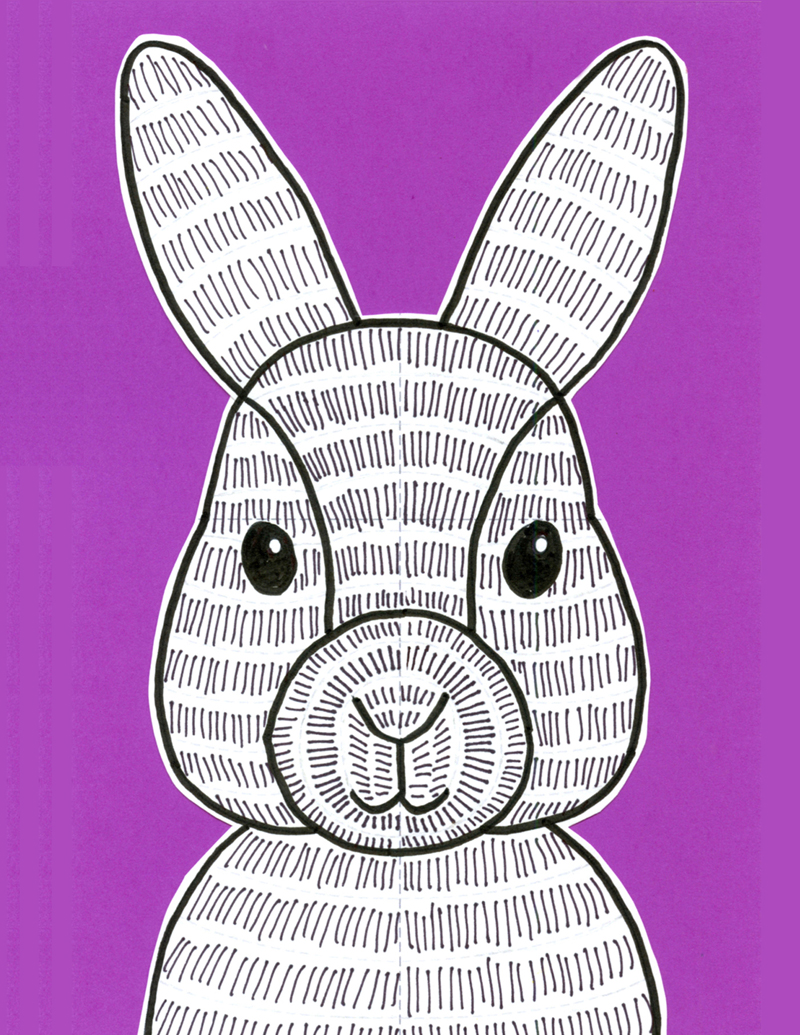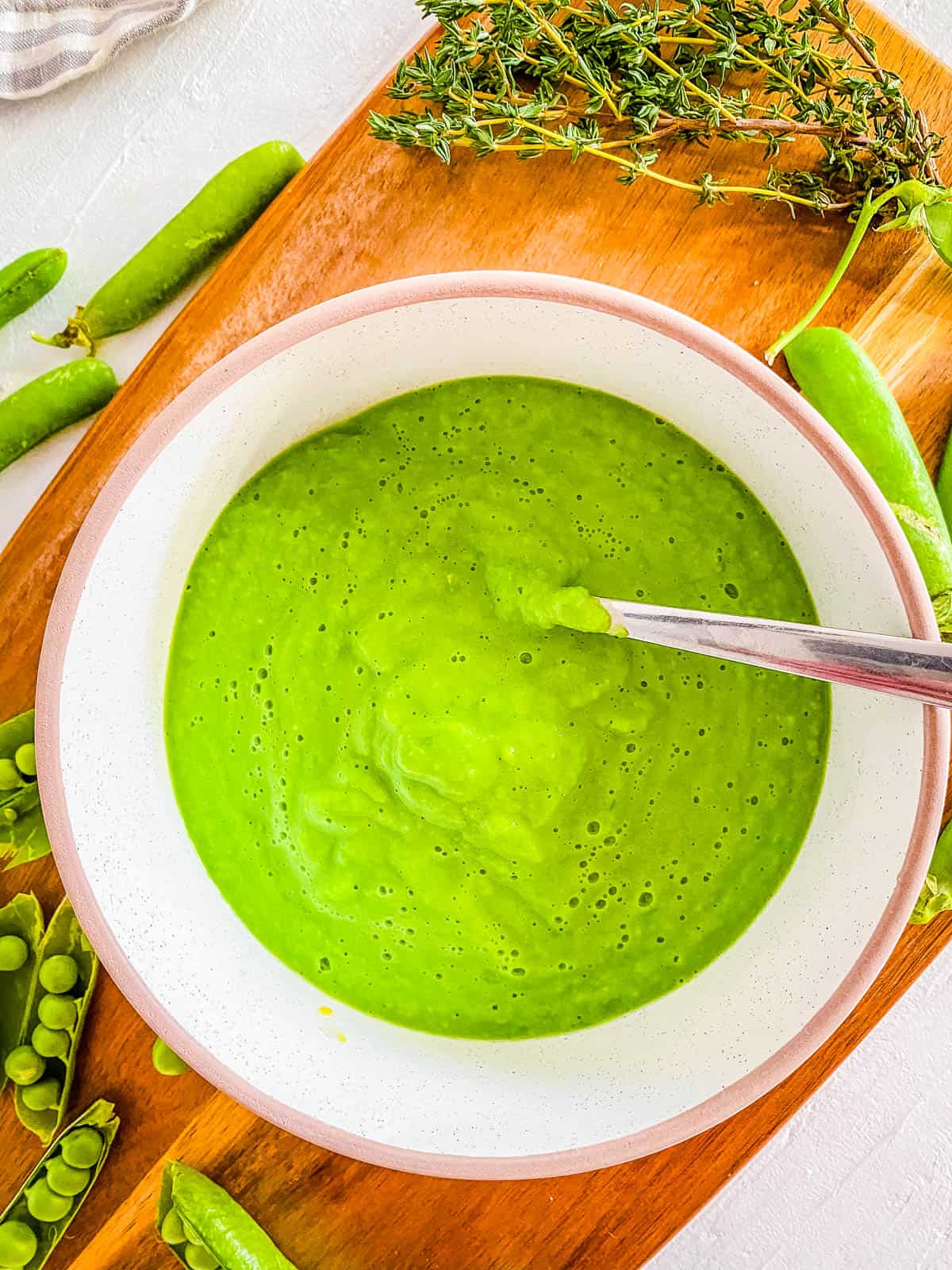
This post may contain affiliate links. As an Amazon Associate, I earn from qualifying purchases. Please read my disclosure.
Rich in protein, fiber, vitamins, and minerals, my peas baby food is the ideal stage one baby food for infants as young as 4 months old. Made with just two simple ingredients, it has a fresh, mild flavor, and learning how to make pea puree for baby is easy!
If you’ve never made baby food from scratch before, it might seem intimidating, but making homemade baby food peas is actually super easy and cost-effective.
My green peas baby food has a mild taste with a creamy texture that your baby will love! It’s also very healthy for your little one and easy to customize based on your baby’s age and tastes.
If it’s your first time making baby food at home, check out my quick start baby food recipe guide!
???? When Can Babies Start Eating Peas?
Babies can start eating peas as soon as they are ready to start solid foods, typically between 4-6 months of age. At that age, for a stage 1 baby food, I would puree the peas or mash them before serving them to my baby.
Similar to grapes, whole peas are a choking hazard until your baby is about 3 years old. At about 12 months old I would start making mashed peas for my kids and I’d serve them as a finger food. Mashed peas were really easy to make when my kids were toddlers – once cooked, I’d simply mash them with a fork or potato masher.
???? Do Peas Make Babies Gassy or Constipated?
Peas should not cause gas or constipation in your baby. Peas are high in fiber, so they should actually help to alleviate constipation because the fiber helps to soften your baby’s stool and make it easy to pass.
My pea puree recipe for baby is one of the best first food options for babies as young as 4 to 6 months old. It has a fresh, mild flavor, making it perfect for infants. Both of my kids started eating this puree around 5 months of age.
This is one of my favorite purees, because sweet peas are a powerhouse vegetable that is allergen-friendly and nutrient-rich. They are high in vitamins A, B6, C, K, folate, iron, and zinc, supporting immune health, bones, and red blood cell formation. Plus, peas are high in protein, fiber, antioxidants, and phytonutrients (source).
I also love that making pea puree for baby is super easy and affordable! My recipe only calls for one ingredient plus water. It’s simple to make and so much cheaper than buying a store-bought brand like Gerber baby food peas.
Another great thing is that you can take my recipe and create many different pea puree combinations for baby. There are so many different variations you can make by mixing it with other baby food or simply adding herbs (see my suggestions below!)
But my favorite thing about my peas baby food is that you can actually make a huge batch and store it in the freezer for months later, making quick meals for your baby ready in minutes!
Latest Recipe Video!
???? Ingredients
You only need two simple ingredients to make my baby peas recipe and one is water! For detailed instructions and nutritional information, see the recipe card at the bottom of this post.

Frozen Green Peas: I recommend using frozen organic peas since they are flash frozen when picked, requiring no extra prep. You can also use garden fresh peas, but they require more prep time, especially if still in their pods. I used 2 bags of 16 oz peas for this recipe.
Water: Used to thin out the puree, I always start with 8 ounces of filtered water. You can always add more water one ounce at a time until you reach your desired consistency.
???? How To Make Peas Baby Food
Learning how to puree peas for baby is really easy and takes just a few steps! Check out my video below to see the step-by-step process in action.
Steam The Peas: To begin, I add a little water to a large pot and place a steamer basket on top. Then I steam the peas for 3-5 minutes until they are tender.
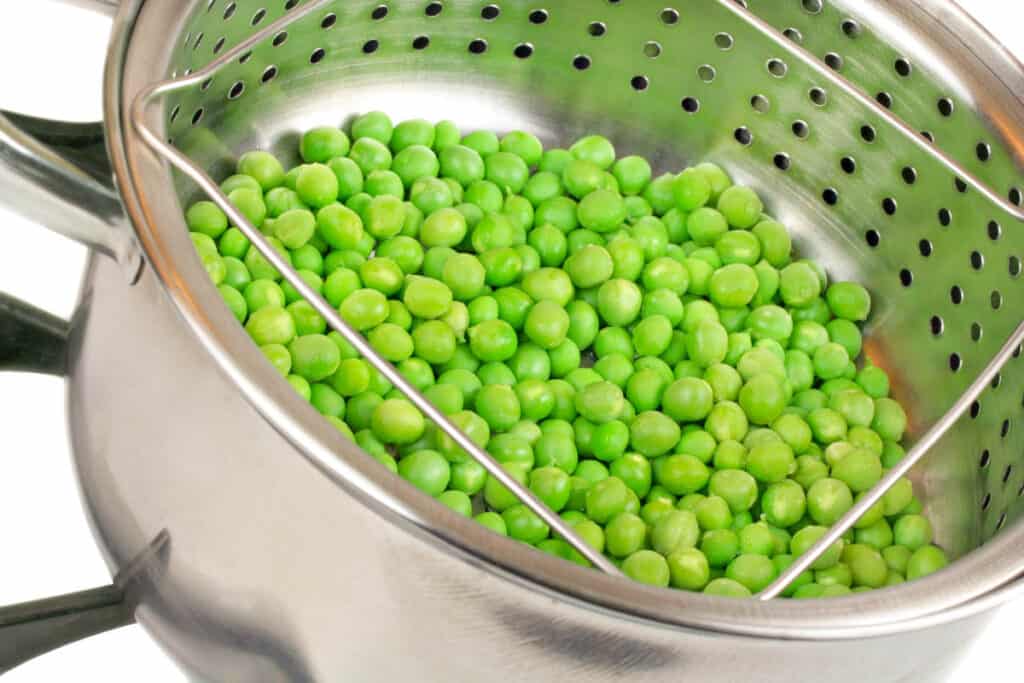
Puree Peas: After the peas are steamed, I pour them into a blender or food processor and add about 8 ounces of water. I blend until smooth, adding more water one ounce at a time if needed to achieve the desired consistency. You can also just add the water to the pot and use a hand blender.
Note: Boiling the peas is another option. I simply add the peas and water to a pot over high heat and bring to a boil. Next, I cover the pot and reduce the heat to a simmer, cooking the peas for about 5-7 minutes until tender but not mushy. Then I add both the cooked peas and the cooking water in the blender.
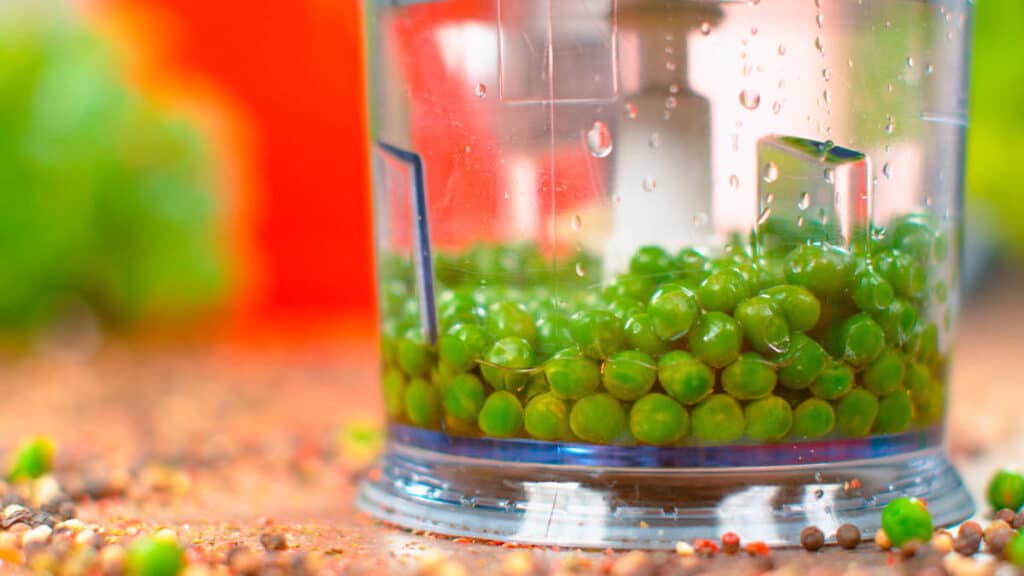
Prepare For Freezing: Once blended, I pour the puree evenly into ice cube trays. Then I let it cool, wrap the trays in plastic wrap or cover them, and pop them in the freezer. The cubes will keep in the freezer for up to 4 months.
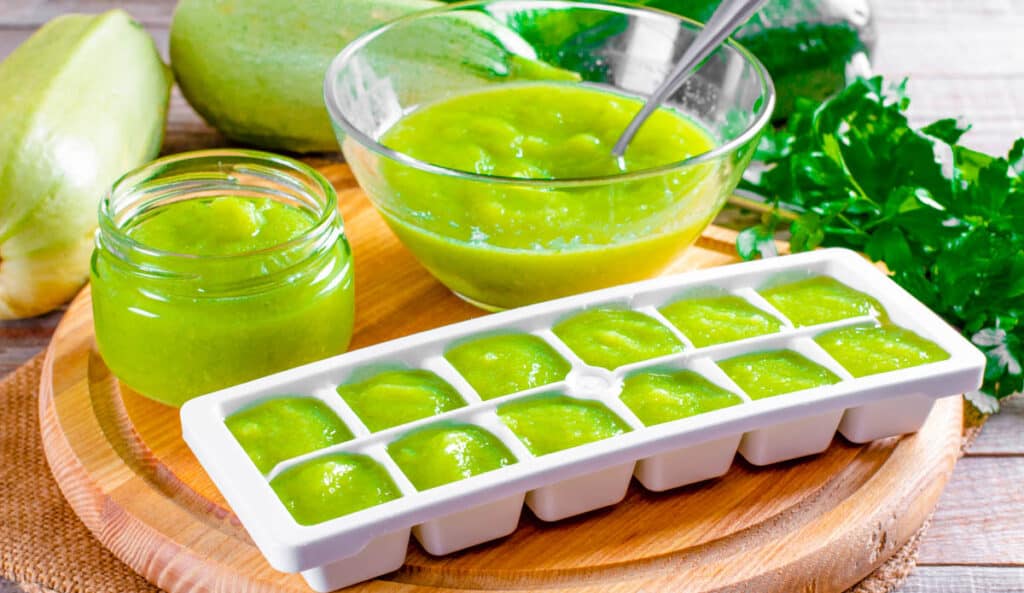
Thaw To Serve: When ready to use, I thaw a cube overnight in the fridge in a small bowl. You can also place the cube in a bowl over hot water on the counter until it is completely defrosted. Pureed peas for baby can be served at room temperature or slightly warmed.
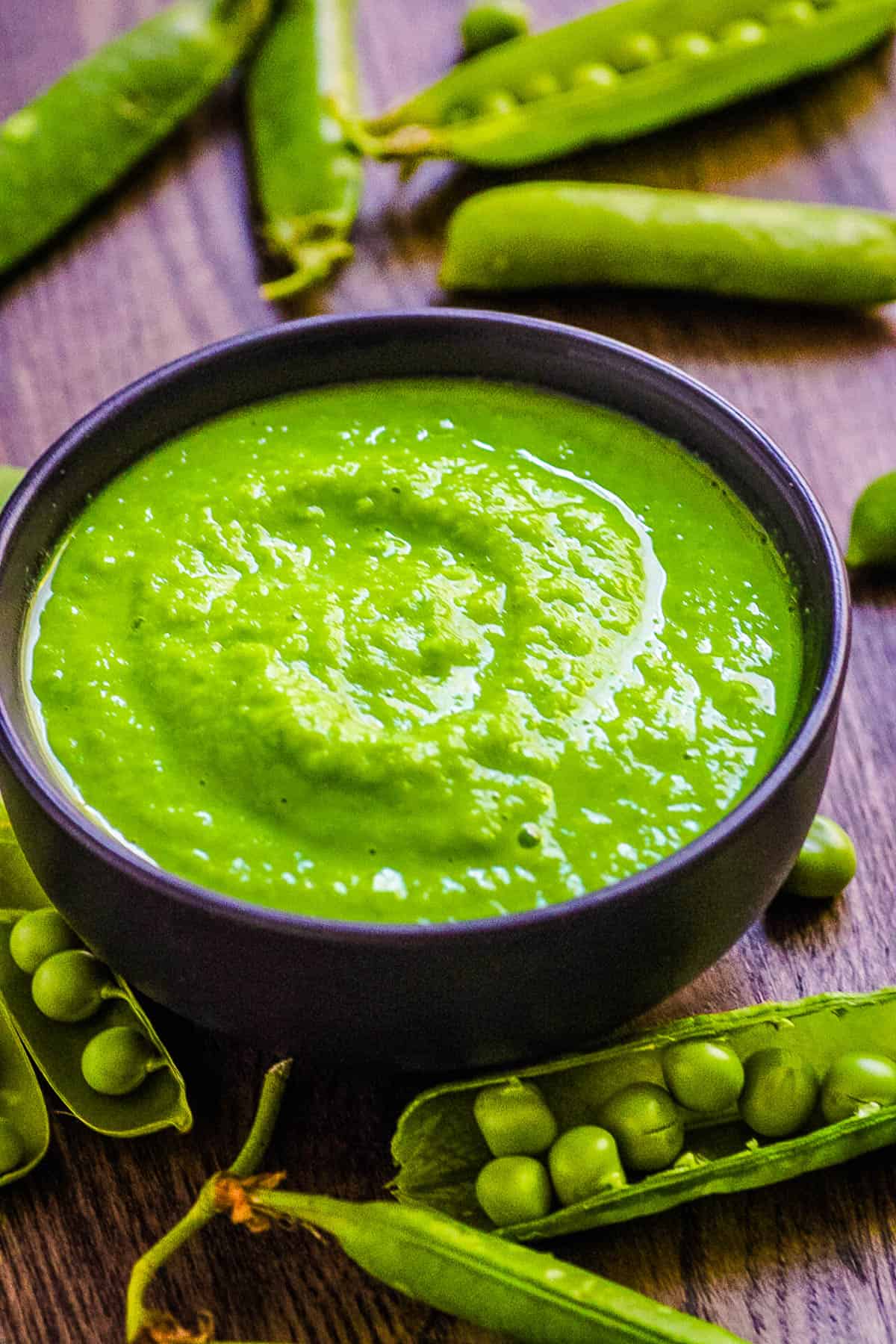
My #1 Secret Tip for when making my baby pea puree is not to overcook the peas! Steam the peas until they turn bright green and are slightly soft to retain their vibrant green color and nutritional value. Once cooked, immediately submerge them in an ice bath to stop the cooking process.
Other Tips To Keep In Mind:
- Use Baby Food Storage Containers: This allows you to make one batch, freeze, and have a supply for the entire month or more! You’ll save tons of time and always have a variety of fresh, homemade purees ready for your baby.
- Use A High-Powered Blender: I used a Vitamix. It can handle large batches and pulverizes everything into a smooth texture similar to store-bought baby food. You don’t need a “baby food maker”. And if you have a Vitamix you can use it for so many other things besides baby food!
- Adjust The Consistency: If your pea puree for baby is too thick I just add a little more water. You can also add breast milk or formula just before serving to your baby.
- Introduce New Flavors Gradually: I recommend starting with single-ingredient peas for babies and gradually introduce new flavors and combinations. This helps identify any food allergies and allows babies to adjust to new tastes.
???? Pea Baby Food Combinations
Deciding what to mix with pea puree for baby is the fun part! The possibilities are endless. Here are some of my favorite peas combination baby food ideas:
Peas And Apples: Some babies may not like peas on their own, but they can be made palatable by mixing them with another fruit puree! My kids always loved apple and pea puree. Other fruits like pears, bananas, peaches, and mangoes are good options too.
Peas And Carrots: Smashed peas and carrot baby food is a classic combination! I would also use other vegetables like sweet potato, butternut squash, cauliflower, or regular potatoes when serving this to my kids and they all worked well.
Other Green Vegetables: Take my baby pea puree recipe and blend in some other green veggies like spinach or broccoli. You could also mix it together with my zucchini baby food or pureed green beans.
Add Protein: Baby food with peas is easy to mix together with chickpeas, my easy baby lentils recipe, yogurt, or even soft tofu for a protein boost!
Add Healthy Fats: Try mixing in some ground flaxseed, avocado puree, or a little bit of olive oil, coconut oil, organic ghee, or butter! You can also mix it with breastmilk or organic baby formula right before serving (but do not mix it with breastmilk or formula and store it for later).
Herbs & Spices: When considering what to mix with peas for baby food don’t forget about herbs and spices. I introduced mild herbs and spices to both of my kids at around 7-8 months of age. You can try fresh herbs like mint, basil, parsley, or cilantro. Other flavors and spices that your baby might enjoy include a splash of lemon juice or lime juice, or a pinch of ground ginger, garlic powder, or cumin.
???? How To Serve Peas To Baby
Once your baby is ready for solids, you can add a little bit of green pea puree to a small baby-safe spoon and let your baby experiment with it. Let them touch it, put little bits in their mouth, and see how they like it.
Alternatively, you can feed it to them directly if they are leaning forward and opening their mouth already.
When you start solid foods, 1 tablespoon of my peas baby food is more than enough for a “meal.” So start with small amounts and work your way up from there as your baby gets used to eating!
Other Quick Feeding Tips
- When it comes to starting solids, the best way to ensure your child becomes an adventurous eater (and not a picky eater), is to expose them to different tastes and different textures (besides sweet, soft foods) early on.
- Follow your baby’s lead! Don’t try to make your baby eat once they’ve indicated they are full or done (e.g. they have turned away from the spoon, stopped opening their mouth, or started playing with or pushing away the food). It’s also ok to let your baby explore with the spoon and the food on their own. It will make a mess, but it encourages your baby to develop key skills for self feeding.
- Be persistent! Sometimes it can take up to 50-100 tastes of new foods for a baby to accept them. If your baby doesn’t like the puree at first, keep trying, and don’t give up!
- Add spices to my peas baby food recipe! Don’t be afraid to expose your baby to all kinds of tastes and flavors. Avoid using “hot” spices like chili powder, cayenne, or red pepper, but mild and sweet spices, as well as all herbs, are great options.
✔️ Serving Suggestions For Older Babies, Kids, And Adults
Once you know how to make peas for baby you can transform it into a recipe that you can use for older babies, kids, and adults too. It is really easy to modify my pea baby food recipe with very little effort.
Older Babies: To make a stage 2 pea puree for baby, leave some chunks in the puree for more texture. This introduces them to a different consistency while still being easy to eat. Spread the chunky puree on some toast for baby led weaning.
Toddlers: Turn mushy peas for baby into a smoothie by blending it into this pineapple cucumber smoothie or fruit and vegetable smoothie. You could also mix some into my oat flour pancakes, rice, or pasta to sneak in some more veggies.
Older Kids and Adults: Use my pea puree as a dip, spread, or sauce. Blend the peas with garlic, lemon juice, and a bit of olive oil to pair with crackers or flatbread. You also can use it on this grilled cheese pita sandwich or these black bean quinoa burgers.
???? How To Store
Fridge: Once the green peas for baby cool completely, I transfer them to an airtight container and place them in the fridge for up to 4 days. When ready to serve, I reheat the puree slightly in the microwave and then test how warm it is before serving. A little warmer than room temperature (or just at room temperature) is perfect.
Freezer: For longer storage, I portion the puree into ice cube trays, like these from Mumi & Bubi or a covered silicone ice cube tray, and freeze the baby food overnight. You can also use plastic wrap. Once the puree is frozen, I pop the cubes out and store them zip-top freezer bag for up to 4 months.
Defrost: When ready to use, I transfer the desired number of pea puree cubes to the refrigerator overnight. The next day, I stir the thawed puree and warm it slightly in the microwave.
❓Recipe FAQs
Yes, you can use frozen peas when making my pea puree for baby. But do not serve your baby frozen peas without pureeing them, as they are a choking hazard.
I do not recommend using canned peas for baby food. Some cans still contain BPA. Also, they are not as fresh or flavorful. In fact, they can have quite a pungent smell and acidic flavor.
Whole peas can be a choking hazard for babies, especially those under 3 years old. It is important to puree or mash the peas thoroughly before serving them to infants and younger toddlers. As your child gets older and can handle more textures, you can serve peas that are mashed or broken into smaller pieces to reduce the risk of choking.
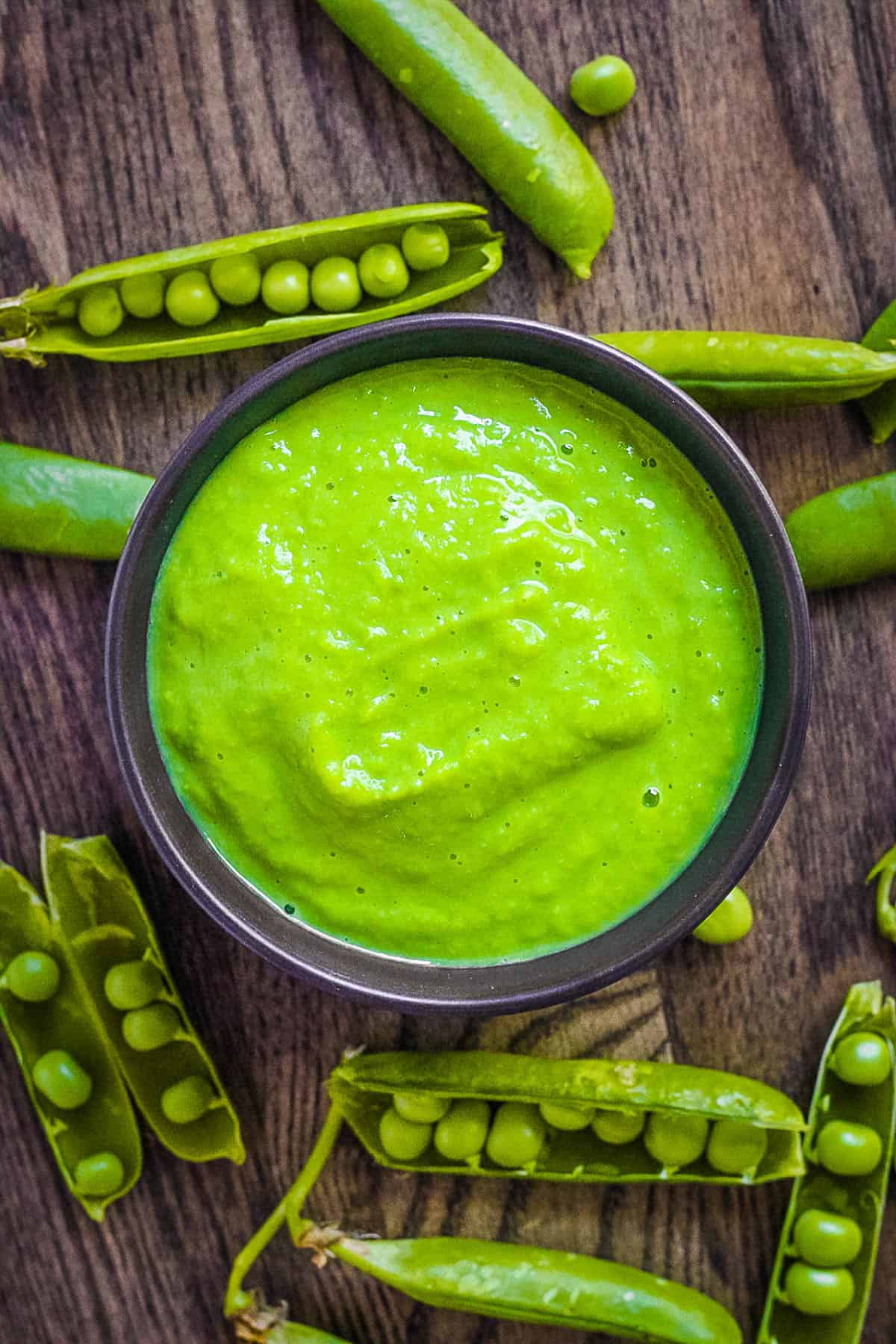
Want to Save This Recipe?
Enter your email & I’ll send it to your inbox. Plus, get great new recipes from me every week!
By submitting this form, you consent to receive emails from .
Love this baby food recipe? Please leave a 5-star rating ???? in the recipe below and/or a review in the comment section further down the page!
You can also FOLLOW ME on FACEBOOK, INSTAGRAM, and PINTEREST to see more delicious, healthy, family-friendly food, and if you have any questions, I’m here to help!
???? Recipe Card
Peas Baby Food (Stage One)
Rich in protein, fiber, vitamins, and minerals, my peas baby food is the ideal stage one baby food for infants as young as 4 months old. Made with just two simple ingredients, it has a fresh, mild flavor, and learning how to make pea puree for baby is easy!
Servings: 14 ounces
Calories: 52kcal
Shop Ingredients on Jupiter
- Mix with your baby’s favorite fruit or some sweeter veggies (butternut squash works great) to make peas more palatable!
- This recipe can make anywhere from 12-16 ounces depending on how much water you use.1 ice cube = 1 oz of food
- Stage 1 Food: 4 months and up
- Use baby food storage containers. This allows you to make one batch, freeze, and have for the entire month or more! You’ll save tons of time, and have a variety of fresh and homemade purees to give to baby.
- For a super smooth puree, I recommend investing in a high powered blender. I used our Vitamix to puree large quantities at the same time. It pulverizes everything and you end up with a smooth texture (similar to what you’d find in store bought baby food). You don’t need a “baby food maker” – any great blender will do. And if you have a Vitamix you can use it for so many other things besides baby food!
- Don’t overcook the peas! They don’t need a ton of time to steam. You want them to turn a bright green color, and become slightly soft in texture – that’s when they are perfectly cooked.
- Adjust consistency as needed. If the baby puree is too thick add more water. Or add breast milk, or formula just before serving to your baby.
Serving: 1ounce | Calories: 52kcal | Carbohydrates: 9g | Protein: 4g | Fat: 0.3g | Saturated Fat: 0.05g | Polyunsaturated Fat: 0.1g | Monounsaturated Fat: 0.02g | Sodium: 4mg | Potassium: 158mg | Fiber: 4g | Sugar: 4g





